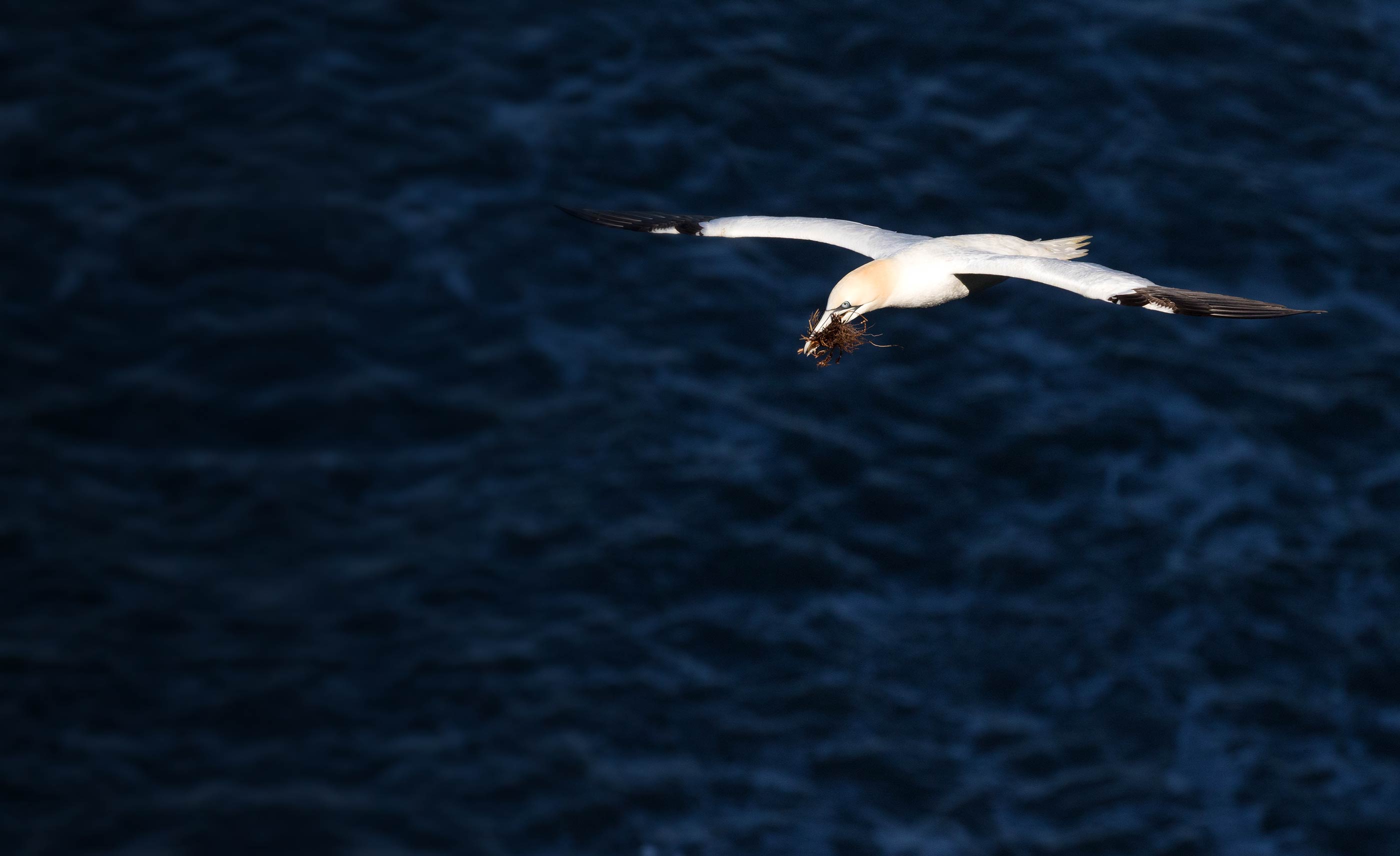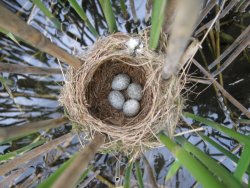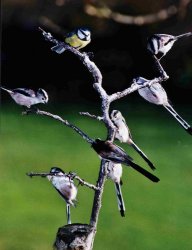Delayed breeding on CES in 2013
First Reed Warbler nest in May showing how little new
reed (the green stems) had grown.
At 131 sites across the UK and Ireland, CES ringers undertake 12 visits between May and August each year, placing their nets in the same positions; some have been doing this for over 30 years, providing valuable data about changes in numbers of adults, breeding success and survival over time. Last year the CES results clearly demonstrated that, while adult abundance and survival were average for most species, the number of juveniles produced was the lowest since the scheme began in 1983.
We are several months away from being able to produce these figures for this year (watch this space) but reports from the ringers themselves give an indication of how their season is progressing compared to previous years and averages.
Early May
Garth (Worcestershire), Kevin (Hampshire), Chris (Cambridgeshire), Colin (Suffolk) and Lynne (Hertfordshire) were among those reporting good first CES sessions, with resident species finally showing signs of breeding. However, Pete & Ginny (Buckinghamshire) and Andrew & Roger (Kent) were less enthused, finding that numbers of birds caught were well down on the average. Tim (Berkshire) was particularly concerned about the lack of Blackcap and Chiffchaff.
Mid May
Kevin (Hampshire) and Roger (Devon) reported good numbers of returning Reed Warbler, but Dave’s (Norfolk) population made a late start due to incredibly delayed reed growth. Continuing the trend for low numbers or short-distance migrants, Elizabeth (Oxfordshire) noted that Chiffchaff were few and far between.
Late May
Garth (Worcestershire), Jan (Berkshire), Dave (Norfolk), Jacquie (Norfolk/Suffolk border) and Roger (Devon) all experienced below average catches, with Reed Warbler, Sedge Warbler and tits all being of concern, though at least some juvenile Robin, Dunnock and Long-tailed Tit were starting to appear.
Tit flocks were notable by their absence in
the first half of the CES season.
Early June
Chris (Cambridgeshire) and Garth (Worcestershire) were among those being encouraged by the arrival of a few juveniles on the wing. Long-tailed Tit, Song Thrush, Robin, Blue Tit and Chiffchaff all found their way into Chris’s nets, albeit belatedly. Pete & Ginny (Buckinghamshire) and Colin (Suffolk) were among those still lacking juvenile warblers, though Tim (Berkshire) had his first youngsters of the year, including four Whitethroat with wings not yet fully grown. Jacquie (Norfolk/Suffolk border) did report one Long-tailed Tit flock, a sight others were still were lacking.
Mid June
Roger (Devon) had his best catch of the year so far, mainly due to two flocks of Long-tailed Tit while Jan (Berkshire) had his worst ever capture for the fifth CES visit, with low numbers of both Reed and Sedge Warbler. Chris (Cambridgeshire) was really chuffed with his juvenile Nightingale, the first of the year, along with juvenile Blackbird, Blackcap, Dunnock, Willow Warbler, Treecreeper, Lesser Whitethroat, Wren and Great Tit. For Andrew & Roger (Kent), their two juvenile Whitethroat were exactly a month earlier this year than last but they still lacked juvenile Blackcap and the number of adults of resident species was well down. Lucy (Norfolk/Suffolk border) was finally getting quite a lot of juveniles of the residents and short-distance migrants but a lot fewer of the long-distant migrant warblers than usual. One of her female Reed Warblers was just starting to form a brood patch while she also had Treecreeper that had started wing moult, so clearly thought it was autumn already!
Late June
The sixth visit takes people to half way through the CES season – a good time to review caching for the first half of the season. Jan (Berkshire) was running at 75% of the average for the first six visits with Sedge Warbler 49% below average. Mark (Cornwall) had only 56% of 2012 numbers, with a surprisingly high number of Reed Warbler but a concurrent lack of variety, Blue Tit, Reed Bunting and Chiffchaff all being notable by their absence. Kevin (Hampshire) was doing well in terms of Reed Warbler too, but all other target species were down on 2012. Colin (Suffolk) was an exception, with numbers above average, particularly in terms of juvenile Chiffchaff, Blackcap and Dunnock, though Blackbird appeared to be struggling. On the other hand Dave (South Yorkshire) was looking at one of the worst years of the 25 that he had been operating the site, though had slight optimism as visit six produced double the numbers of 2012, including the first tit flock of the year.
In summary
Reports thus far paint a very varied picture. In summary, feedback would suggest that:
- The number of adults that have returned has varied greatly between species and regions. Overall, CES participants seem more concerned about resident species than migrants.
- Migrants were later than normal returning.
- Young birds of all species are very late appearing, and, across all species, have been more synchronous than average. The first juvenile tits appeared at a similar time as the fledgling warblers, when they are typically several weeks earlier.
- There is some optimism that the number of juveniles produced won’t be too low for many species, though there are notable exceptions.
Just how accurate is this assessment of the season? We’ve still got half the CES season to go, but the preliminary results will be produced in November, so keep an eye on the website.












Share this page